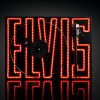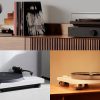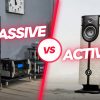Why, in home movies, DVDs or Blu-ray, is there such a big dynamic range? You go through a soft passage where you can barely hear the dialog and a second later… BANG! . .the whole house is shaking with extremely high volumes. The reason I say home movies is because this high dynamic range doesn't seem so high at movie theaters for some reason — or at least not to me. The dynamic range of movies viewed at home seems to be much more extreme than in the cinema.
"There's no question that the dynamic range of Dolby Digital soundtracks on lots of special effects blockbuster movies is too great for a lot of domestic environments. The mix is certainly the same as the one used in commercial movie theaters. I think there are a couple of factors that somehow make the huge dynamic range more acceptable in a large cinema than at home.
The size of the space and number of bodies in the seats plus all the absorptive upholstered seats in big theaters somehow "soaks up" the dynamic range better. At home, our relatively small rooms just generate too much immediate and very loud reverberant energy that can't go anywhere and get absorbed, so it's just too much acoustic energy impinging on our ears," said Alan Lofft.
Dr. Floyd E. Tools says, "Actually it is probable that the reverberation time in typical homes is lower than that in typical cinemas. Some of what we experience may be related to expectations — big room, big screen, big sound: OK. Small room, small screen, big sound: maybe not. Personally I have never had a problem, but I never play movies at "0" dB "reference" level. Most people play movies several dB lower at home."
Alan Lofft continues, "The ambient noise level in a house from the heating/AC system plus a refrigerator/freezer and outdoor city urban noise is usually significantly higher than in movie theaters. Cinemas are quite well insulated to keep the ambient noise at a very low level so the available dynamic range can be played without having the peaks at deafening levels."
Dr. Floyd E. Tool stated, "When I saw "Avatar" at an IMAX, I could hear the air conditioning units on the roof, and hum from the amps through the loudspeakers — cinemas screw up too! The bass was obviously "one note", but I don't know whether that was the playback or the recording. Have you ever noticed the similarity in explosive sounds in movies and on TV — I think they all use the same "boom" clip."
"At home, ambient noise causes us to shift the range higher so the softer sounds can be heard above background levels, then when a peak comes along, it's way too loud, says Alan Lofft.
Dr. Floyd E Tool replies, "Yes, this could happen, but the background noise would have to be quite high — and I guess in some homes it could be.
First of all we cannot assume that the soundtrack on a disc and that in the cinema is identical — the sound on the disc has gone through an additional mastering operation during which an engineer has the opportunity to alter a number of variables, including dynamic range. We don't know what, if anything has been changed, which makes discussion of this observation a bit uncertain.
However, assuming that the soundtracks are identical, there is another variable — the audio system in the cinema itself. If we are talking about top-line cinemas the dynamic range and bandwidth can be substantial. If we are talking about older cinemas or your local multiplex, the audio system may well not be up to the highest standards in terms of being able to reproduce the lowest frequencies, or the highest sound levels, resulting in less "impact" during big sound effects. So-called "standards" for setting up cinemas are sadly inadequate, and individual operators are sometimes known to go in after calibration and set things the way they like them. Frankly, if you have truly good loudspeakers, including subwoofers, at home, and have properly set up your own system, you may well be hearing something better, and closer to what was intended than you might in a garden-variety cinema.
Thinking on the "dark side" perhaps the home system is overloading (amplifiers and/or loudspeakers), causing distortion, clipping, or other sorts of unpleasant misbehavior during crescendos.
If your home system is up to standard, and properly calibrated, and you don't like the "startle" effect of a wide dynamic range, that is a totally different matter, for which there is no technical solution."
Dr. Sean Olive states, "I don't have much to add except that in homes there are other factors that may come into play that influence the "preferred" dynamic range of movies.
Differences in active attention of listener – in cinemas, you are usually giving your full attention to the movie; at home we are often multi-tasking and playing movies at lower playback levels. In this situation, the wide dynamic range may be a distraction to multi-taskers and present a problem with speech intelligibility at lower playback levels. Solutions like Dolby Volume and their dynamic range limiter (for late-night viewing when you don't want to disturb the neighbors) may be a solution for this situation. I have not actually tested Dolby Volume so I can't comment on how well it works. How Dolby Volume Works? (pdf).
Floyd is correct that there are specialists who remix films slated for DVD release. Also, in Zacharov and Bech's book, Perceptual Audio Evaluation, they claim that for most program material, the preferred playback level for most people in their homes is about 10 dB lower than "reference level" when their system is properly calibrated."
Dr. Floyd E. Toole is the former vice-president of engineering for Harman International, a former president of the Audio Engineering Society, and for 25 years was an acoustical scientist at Canada's National Research Council. He is the author of "Sound Reproduction: Loudspeakers and Rooms".
Dr. Sean Olive is the Director of Acoustic Reseach, Corporate R&D, at Harman. He did extensive work at Canada's National Research Council with Dr. Toole prior to joining Harman. He authors a blog, Audio Musings.
Alan Lofft was, for 13 years, Editor in Chief of Sound & Vision, Canada's largest and most respected audio/video magazine. He edited Sound & Vision (Canada) until 1996, when he moved from Toronto to New York to become Senior Editor at Audio magazine. He now works for Axiom Audio.
Photo by Steve Steigman for Maxell in 1979, known as "Blown Away Man." The old Maxell TV commercial can been seen on YouTube.






























